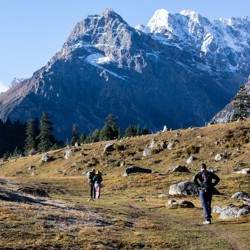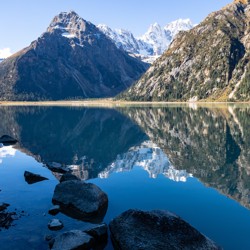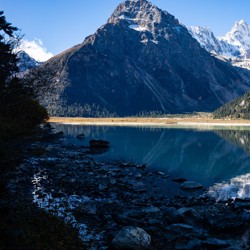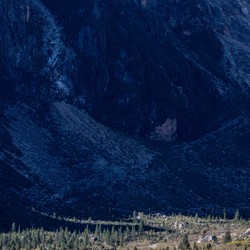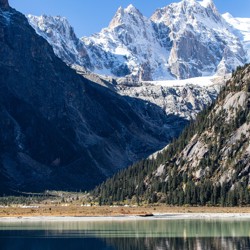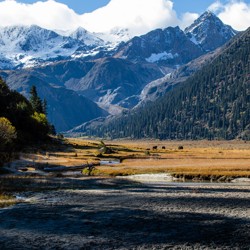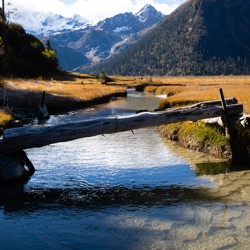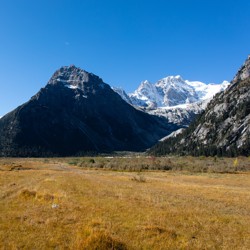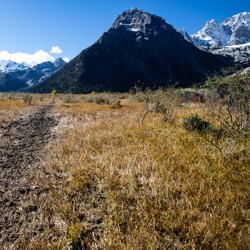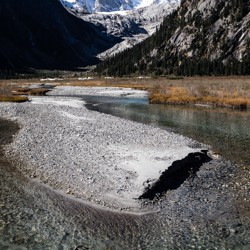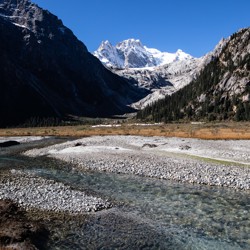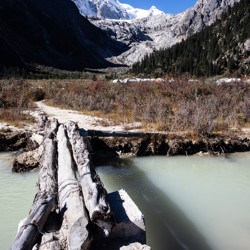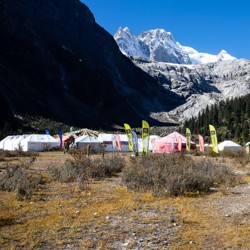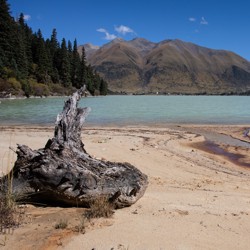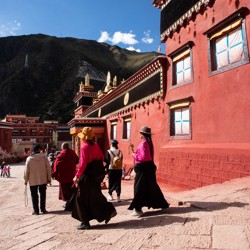03. October 2019
Dege
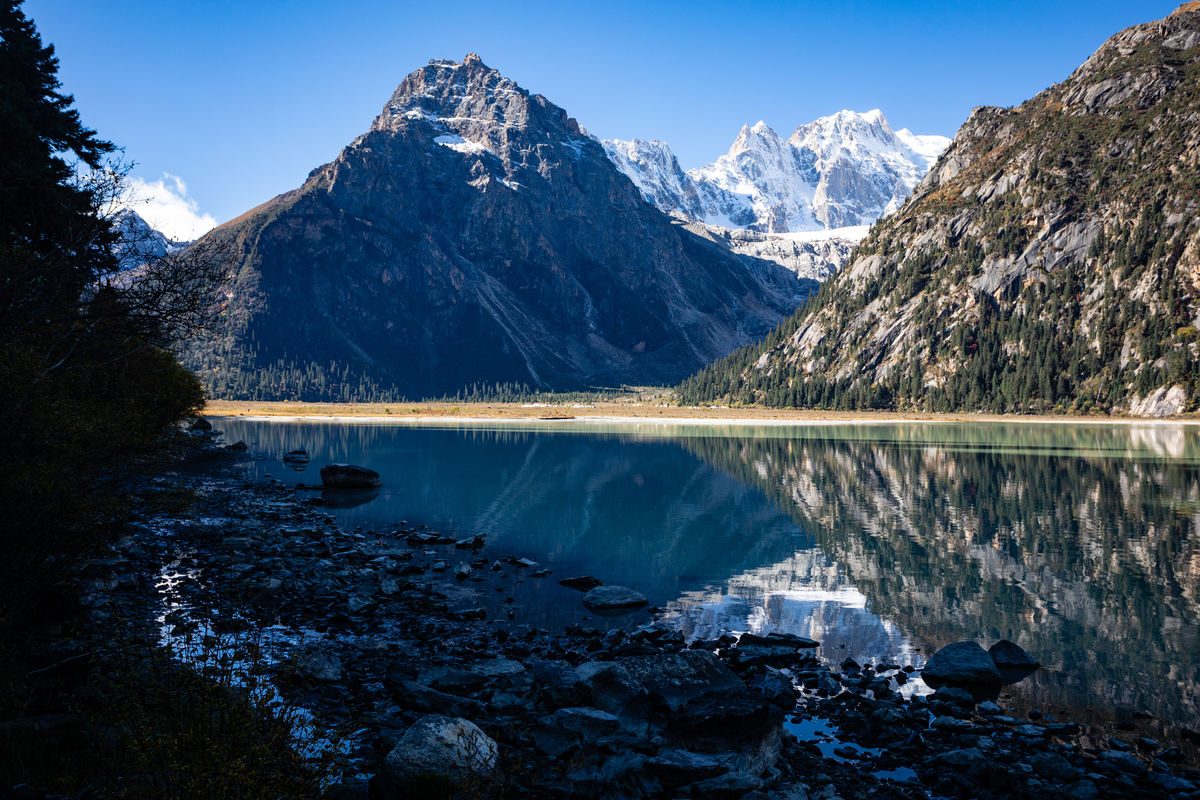
Hitch hiking the 13 kilometers to the lake was very easy and so Daniel and I could start the hike at Yilhun Latso. Elenore had told me back in Ganzi that, according what she had heard and read, it was possible to walk around the lake, but only if one would start in the morning. Later during the day the melting water from the glacier would make passing to the other side more difficult.
Yilhun Latso was indeed a nice, tranquil lake and the views of the mountains in the background were amazing! After taking a few initial photos, we started to follow the trail. Initially we both walked on the stones of the shore, but soon I went to follow a horse trail a little bit higher up while Daniel continued the other way. I had brought my big backpack, partly to get more used to it, partly since I wanted to directly continue to Dege after the hike, and balancing the weight while jumping from stone to stone was a bit difficult.
For a long time I could spot Daniel every now and then walking just a few dozen meters next to me. But at some point, after having a more difficult part with climbing a bit up and down the muddy horse trail, I lost sight of him when eventually the horse trail ended merged with the lower trail again. Was he already that far ahead? Or did he had to walk around some obstacle? Since I didn’t know, I decided to wait for some minutes, but he didn’t turn up. Since this was not a dangerous area and I suspected that he may have been already walked much farther, considering his lighter weight, I finally decided to continue.
Soon afterwards, when I arrived at the plains, the view opened up and I was now close to the base of some of the mountains. Now I just had to find a way to the other side, which was easier said than done. A lot of small rivers criss-crossed the grasslands and while sometimes a few logs had been placed down to help traversing them, often I had to walk around to find a place where the water was very shallow or the river was small enough to jump over to the other side.
Eventually I arrived on the other side and went ahead to some tents, which I had already seen from some distance. They turned out to be a Chinese expedition camp. Some of the expedition members could speak English and we had a nice, short chat. They wondered whether I was also going to try to climb up the mountain - probably due to me carrying my backpack around - and explained that the actual trek would take them four days.
Briefly afterwards I continued on my way. The trail on the western side of the lake was much more difficult. It went up and down all the time and often I had to push away branches. I also had to climb over some fallen down trees and at some parts the earth had slid away. Apparently this trail was not in much use anymore and so I had to move more slowly than before. Finally - so I thought - I made it! The steep trail got flatter and it seemed like I could more or less easily stroll the last few hundred meters back to the entrance.
After a short break I lifted my backpack again to walk the last part only to discover a fence just a bit further ahead, barring the direct way. I climbed up a bit further to try to circumvent it, but it seemed to continue a long way up the mountain. Probably it was supposed to keep people walking into the difficult trail area but now it also kept me from walking out of it. After some searching I found a place where the fence was low enough to climb over and eventually arrived back at the entrance.
Hitch hiking to Dege proved to be much easier than expected. Not even 10 minutes after I placed down my backpack on the side of the road, a minibus full of Tibetans stopped and offered me to take me to Dege for a reasonable fee. Since the bus was already more or less full, we had to move some stuff around to store my backpack and I was allowed to sit in the front, next to the driver and his wife. Without any further obstactles and a short photo stop - the driver wanted to take some photos with him, his wife and me - we arrived in Dege a few hours afterwards.
Since I didn’t want to stay in Dege for long, I first wanted to take care of organising an accommodation and the transportation to Yushu the next day. Finding an accommodation in areas less travelled like these becomes more difficult, since guidebooks as the lonely planet are often really outdated for these parts, but fortunately it didn’t take long to find a hostel. Finding a driver was also surprisingly easy. While walking to the center of the city, I was directly addressed by someone and after I clarified that I wanted to go to Yushu, not Ganzi, he said he would have someone to drive there the next morning. The further discussion was a bit more difficult due to my lack of Chinese language skills and his lack of being able to read Chinese (so the translator app on my phone was not useful), but with the help of an English speaking friend of his I learned that he wanted to know which hotel I was staying in, so that he could pick me up the next morning. I didn’t actually know the name and so he offered me to just walk with me to this place, even though it was almost two kilometers away, and so we did.
Having taking care of everything, I could finally visit the place I was really interested in: The Buddhist printing temple. Founded in the 18th century, the library houses treasures more than 300 000 texts, which are engraved on wooden printing blocks and even today the manual printing continues. It was amazing to wander through the large shelves and watching the printers meditatively doing their work.
Daniel, who planned to go back to Manigango after the hike, was fine. I wrote him an email afterwards and apparently I had been ahead of him, since he wrote me that he saw me later on in the distance.
